MGBBT0UBN - Understanding Business Organisations Essay, Sept 2021
VerifiedAdded on 2023/06/18
|8
|2280
|97
Essay
AI Summary
This essay provides an overview of business organizations, their types, functions, and environments, focusing on Verdant Leisure as a case study. It discusses different business structures like sole proprietorship, partnership, and limited liability companies, highlighting their advantages and disadvantages. The essay compares tall and flat organizational structures, emphasizing the importance of functional management in areas such as HRM, marketing, and finance. Furthermore, it explores the significance of organizational culture, particularly role culture, in fostering employee engagement and improving productivity. The analysis concludes that effective business practices and a positive organizational culture are crucial for the growth and development of business organizations. Desklib offers a wealth of resources, including past papers and solved assignments, to aid students in understanding these concepts.
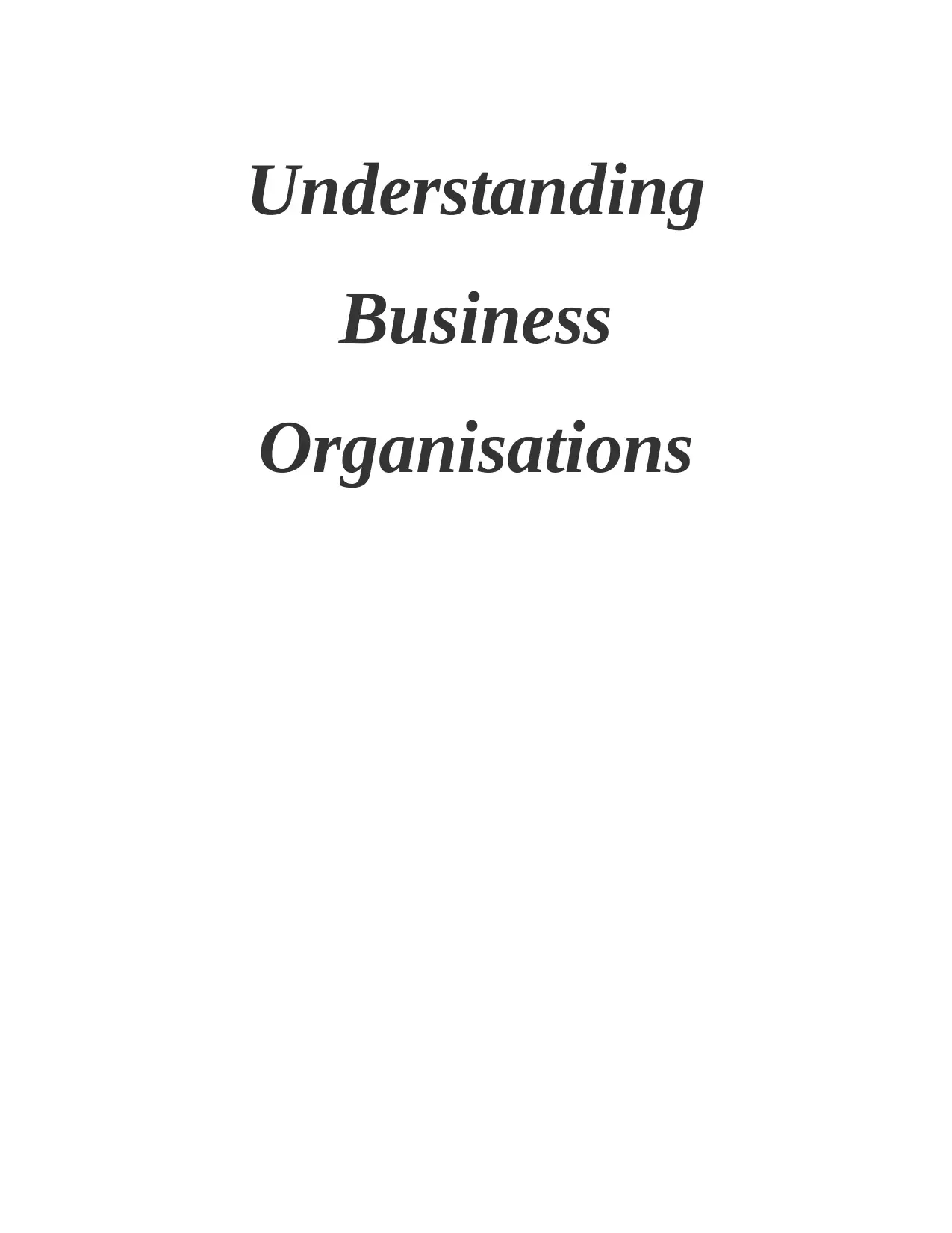
Understanding
Business
Organisations
Business
Organisations
Paraphrase This Document
Need a fresh take? Get an instant paraphrase of this document with our AI Paraphraser
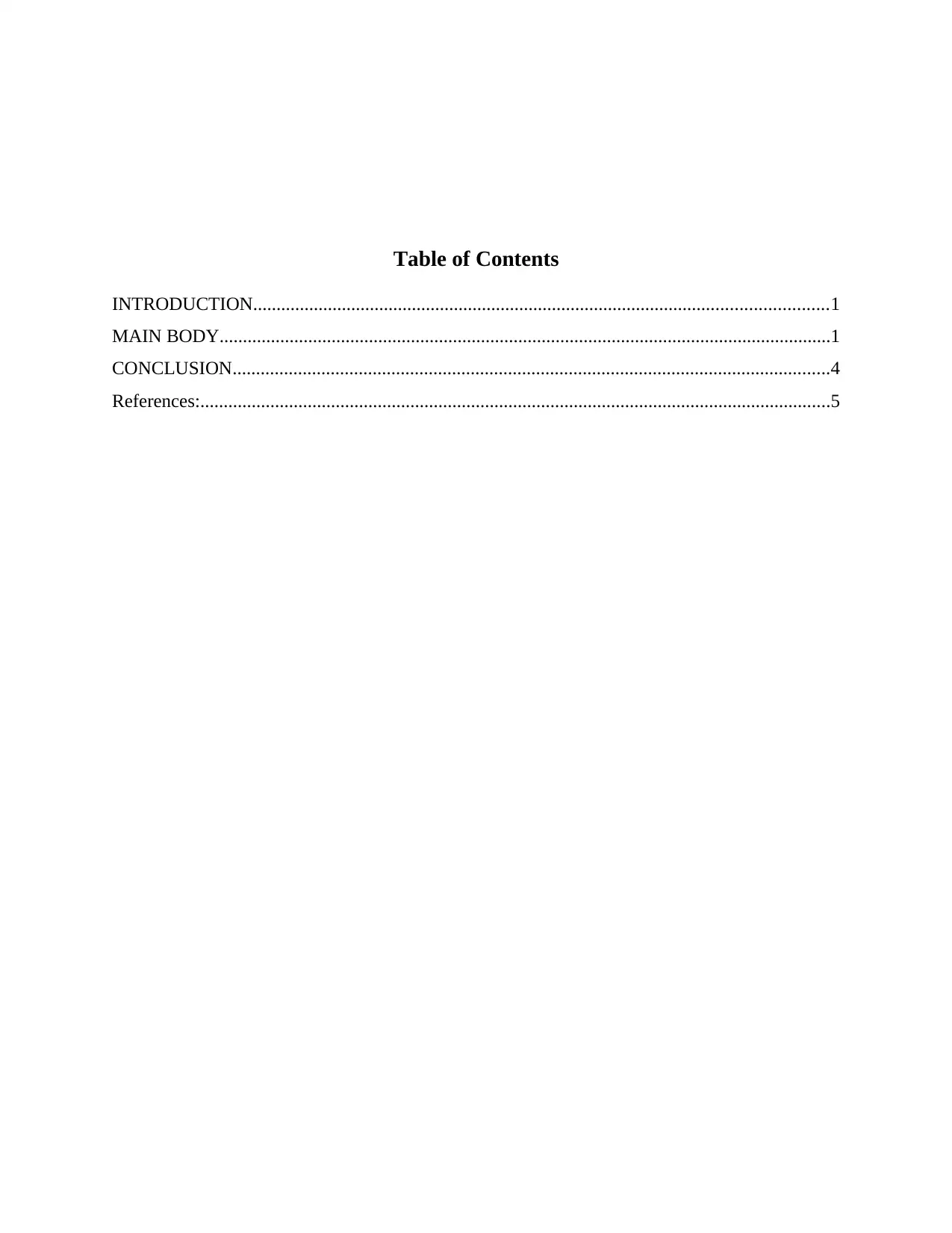
Table of Contents
INTRODUCTION...........................................................................................................................1
MAIN BODY...................................................................................................................................1
CONCLUSION................................................................................................................................4
References:.......................................................................................................................................5
INTRODUCTION...........................................................................................................................1
MAIN BODY...................................................................................................................................1
CONCLUSION................................................................................................................................4
References:.......................................................................................................................................5
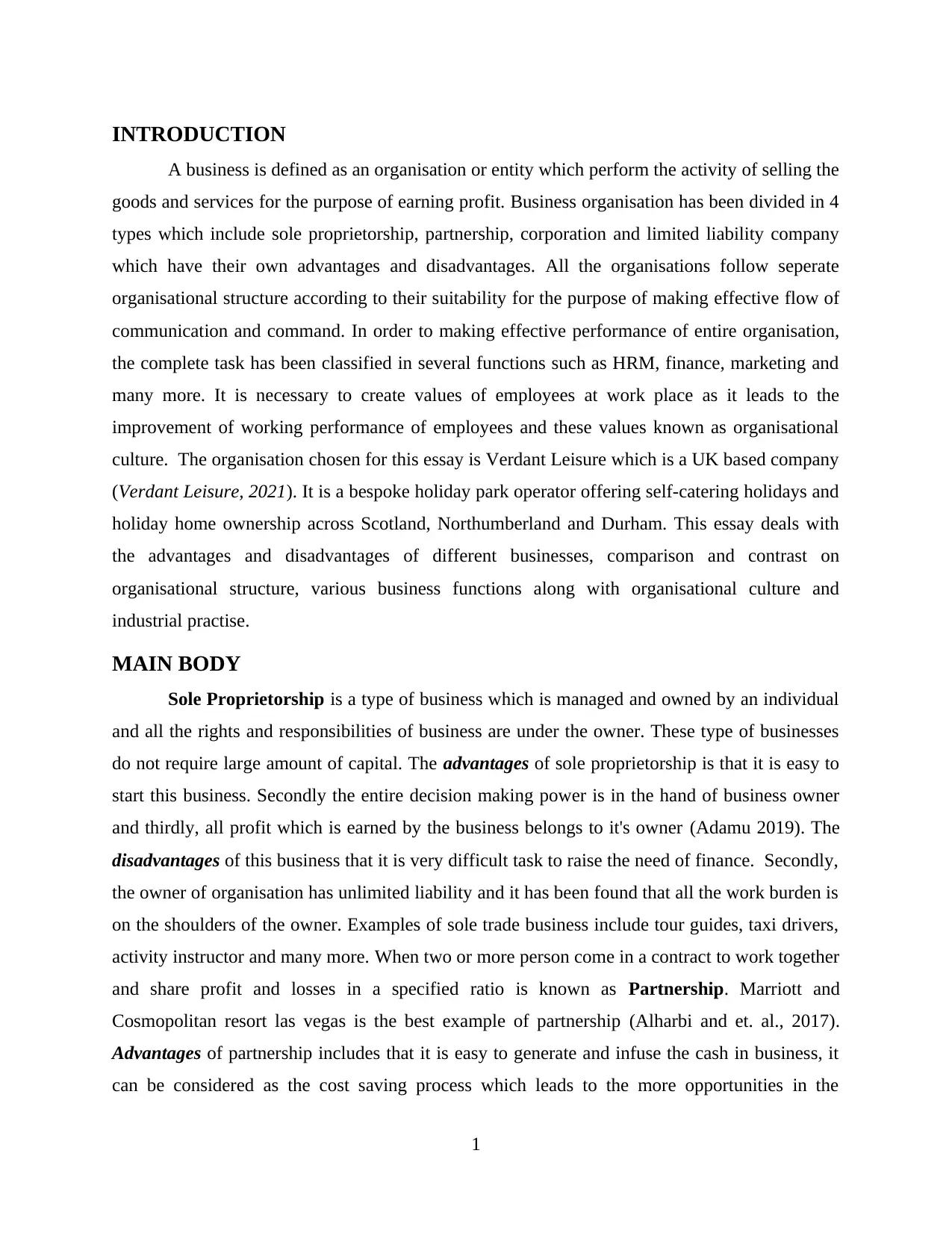
INTRODUCTION
A business is defined as an organisation or entity which perform the activity of selling the
goods and services for the purpose of earning profit. Business organisation has been divided in 4
types which include sole proprietorship, partnership, corporation and limited liability company
which have their own advantages and disadvantages. All the organisations follow seperate
organisational structure according to their suitability for the purpose of making effective flow of
communication and command. In order to making effective performance of entire organisation,
the complete task has been classified in several functions such as HRM, finance, marketing and
many more. It is necessary to create values of employees at work place as it leads to the
improvement of working performance of employees and these values known as organisational
culture. The organisation chosen for this essay is Verdant Leisure which is a UK based company
(Verdant Leisure, 2021). It is a bespoke holiday park operator offering self-catering holidays and
holiday home ownership across Scotland, Northumberland and Durham. This essay deals with
the advantages and disadvantages of different businesses, comparison and contrast on
organisational structure, various business functions along with organisational culture and
industrial practise.
MAIN BODY
Sole Proprietorship is a type of business which is managed and owned by an individual
and all the rights and responsibilities of business are under the owner. These type of businesses
do not require large amount of capital. The advantages of sole proprietorship is that it is easy to
start this business. Secondly the entire decision making power is in the hand of business owner
and thirdly, all profit which is earned by the business belongs to it's owner (Adamu 2019). The
disadvantages of this business that it is very difficult task to raise the need of finance. Secondly,
the owner of organisation has unlimited liability and it has been found that all the work burden is
on the shoulders of the owner. Examples of sole trade business include tour guides, taxi drivers,
activity instructor and many more. When two or more person come in a contract to work together
and share profit and losses in a specified ratio is known as Partnership. Marriott and
Cosmopolitan resort las vegas is the best example of partnership (Alharbi and et. al., 2017).
Advantages of partnership includes that it is easy to generate and infuse the cash in business, it
can be considered as the cost saving process which leads to the more opportunities in the
1
A business is defined as an organisation or entity which perform the activity of selling the
goods and services for the purpose of earning profit. Business organisation has been divided in 4
types which include sole proprietorship, partnership, corporation and limited liability company
which have their own advantages and disadvantages. All the organisations follow seperate
organisational structure according to their suitability for the purpose of making effective flow of
communication and command. In order to making effective performance of entire organisation,
the complete task has been classified in several functions such as HRM, finance, marketing and
many more. It is necessary to create values of employees at work place as it leads to the
improvement of working performance of employees and these values known as organisational
culture. The organisation chosen for this essay is Verdant Leisure which is a UK based company
(Verdant Leisure, 2021). It is a bespoke holiday park operator offering self-catering holidays and
holiday home ownership across Scotland, Northumberland and Durham. This essay deals with
the advantages and disadvantages of different businesses, comparison and contrast on
organisational structure, various business functions along with organisational culture and
industrial practise.
MAIN BODY
Sole Proprietorship is a type of business which is managed and owned by an individual
and all the rights and responsibilities of business are under the owner. These type of businesses
do not require large amount of capital. The advantages of sole proprietorship is that it is easy to
start this business. Secondly the entire decision making power is in the hand of business owner
and thirdly, all profit which is earned by the business belongs to it's owner (Adamu 2019). The
disadvantages of this business that it is very difficult task to raise the need of finance. Secondly,
the owner of organisation has unlimited liability and it has been found that all the work burden is
on the shoulders of the owner. Examples of sole trade business include tour guides, taxi drivers,
activity instructor and many more. When two or more person come in a contract to work together
and share profit and losses in a specified ratio is known as Partnership. Marriott and
Cosmopolitan resort las vegas is the best example of partnership (Alharbi and et. al., 2017).
Advantages of partnership includes that it is easy to generate and infuse the cash in business, it
can be considered as the cost saving process which leads to the more opportunities in the
1
⊘ This is a preview!⊘
Do you want full access?
Subscribe today to unlock all pages.

Trusted by 1+ million students worldwide
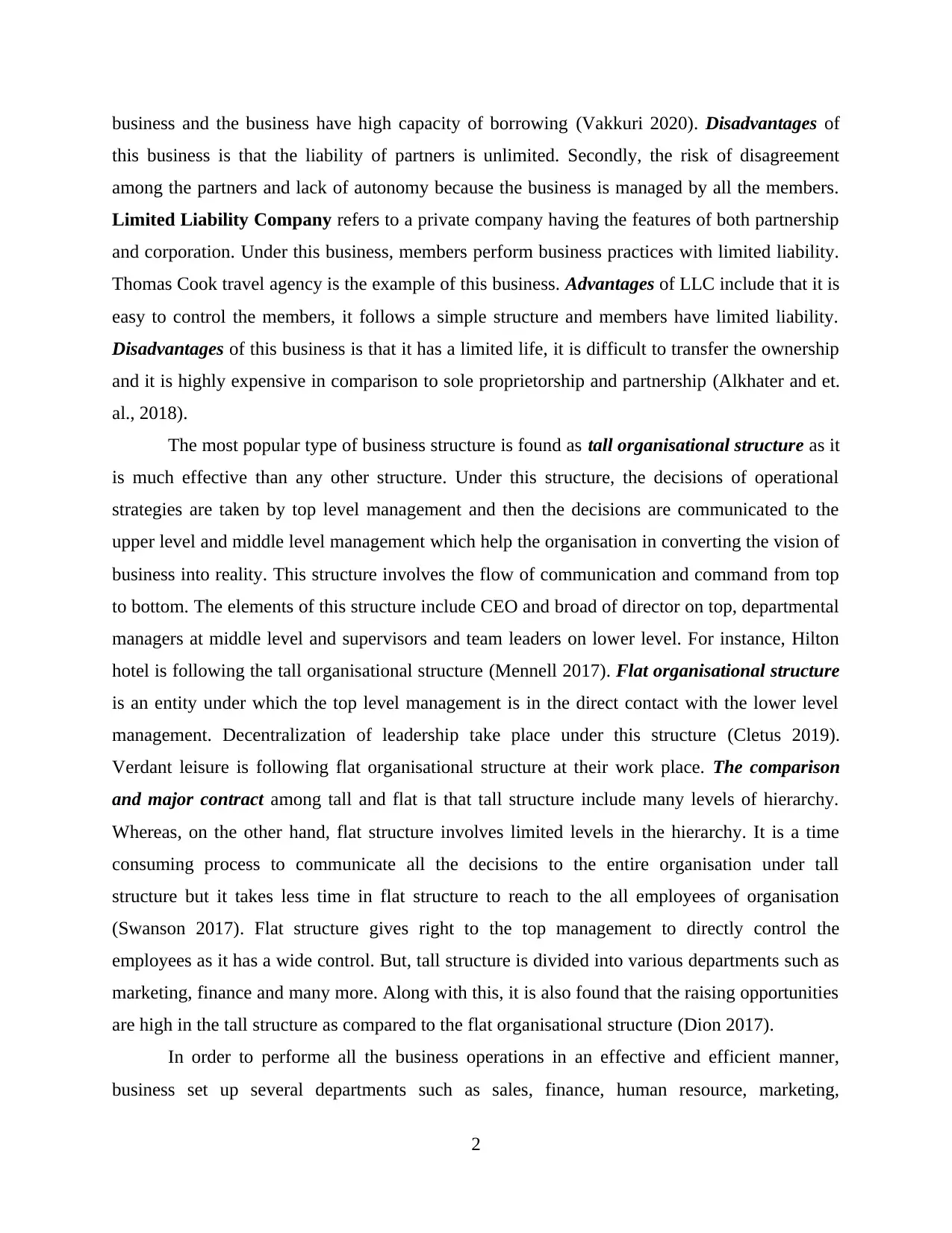
business and the business have high capacity of borrowing (Vakkuri 2020). Disadvantages of
this business is that the liability of partners is unlimited. Secondly, the risk of disagreement
among the partners and lack of autonomy because the business is managed by all the members.
Limited Liability Company refers to a private company having the features of both partnership
and corporation. Under this business, members perform business practices with limited liability.
Thomas Cook travel agency is the example of this business. Advantages of LLC include that it is
easy to control the members, it follows a simple structure and members have limited liability.
Disadvantages of this business is that it has a limited life, it is difficult to transfer the ownership
and it is highly expensive in comparison to sole proprietorship and partnership (Alkhater and et.
al., 2018).
The most popular type of business structure is found as tall organisational structure as it
is much effective than any other structure. Under this structure, the decisions of operational
strategies are taken by top level management and then the decisions are communicated to the
upper level and middle level management which help the organisation in converting the vision of
business into reality. This structure involves the flow of communication and command from top
to bottom. The elements of this structure include CEO and broad of director on top, departmental
managers at middle level and supervisors and team leaders on lower level. For instance, Hilton
hotel is following the tall organisational structure (Mennell 2017). Flat organisational structure
is an entity under which the top level management is in the direct contact with the lower level
management. Decentralization of leadership take place under this structure (Cletus 2019).
Verdant leisure is following flat organisational structure at their work place. The comparison
and major contract among tall and flat is that tall structure include many levels of hierarchy.
Whereas, on the other hand, flat structure involves limited levels in the hierarchy. It is a time
consuming process to communicate all the decisions to the entire organisation under tall
structure but it takes less time in flat structure to reach to the all employees of organisation
(Swanson 2017). Flat structure gives right to the top management to directly control the
employees as it has a wide control. But, tall structure is divided into various departments such as
marketing, finance and many more. Along with this, it is also found that the raising opportunities
are high in the tall structure as compared to the flat organisational structure (Dion 2017).
In order to performe all the business operations in an effective and efficient manner,
business set up several departments such as sales, finance, human resource, marketing,
2
this business is that the liability of partners is unlimited. Secondly, the risk of disagreement
among the partners and lack of autonomy because the business is managed by all the members.
Limited Liability Company refers to a private company having the features of both partnership
and corporation. Under this business, members perform business practices with limited liability.
Thomas Cook travel agency is the example of this business. Advantages of LLC include that it is
easy to control the members, it follows a simple structure and members have limited liability.
Disadvantages of this business is that it has a limited life, it is difficult to transfer the ownership
and it is highly expensive in comparison to sole proprietorship and partnership (Alkhater and et.
al., 2018).
The most popular type of business structure is found as tall organisational structure as it
is much effective than any other structure. Under this structure, the decisions of operational
strategies are taken by top level management and then the decisions are communicated to the
upper level and middle level management which help the organisation in converting the vision of
business into reality. This structure involves the flow of communication and command from top
to bottom. The elements of this structure include CEO and broad of director on top, departmental
managers at middle level and supervisors and team leaders on lower level. For instance, Hilton
hotel is following the tall organisational structure (Mennell 2017). Flat organisational structure
is an entity under which the top level management is in the direct contact with the lower level
management. Decentralization of leadership take place under this structure (Cletus 2019).
Verdant leisure is following flat organisational structure at their work place. The comparison
and major contract among tall and flat is that tall structure include many levels of hierarchy.
Whereas, on the other hand, flat structure involves limited levels in the hierarchy. It is a time
consuming process to communicate all the decisions to the entire organisation under tall
structure but it takes less time in flat structure to reach to the all employees of organisation
(Swanson 2017). Flat structure gives right to the top management to directly control the
employees as it has a wide control. But, tall structure is divided into various departments such as
marketing, finance and many more. Along with this, it is also found that the raising opportunities
are high in the tall structure as compared to the flat organisational structure (Dion 2017).
In order to performe all the business operations in an effective and efficient manner,
business set up several departments such as sales, finance, human resource, marketing,
2
Paraphrase This Document
Need a fresh take? Get an instant paraphrase of this document with our AI Paraphraser
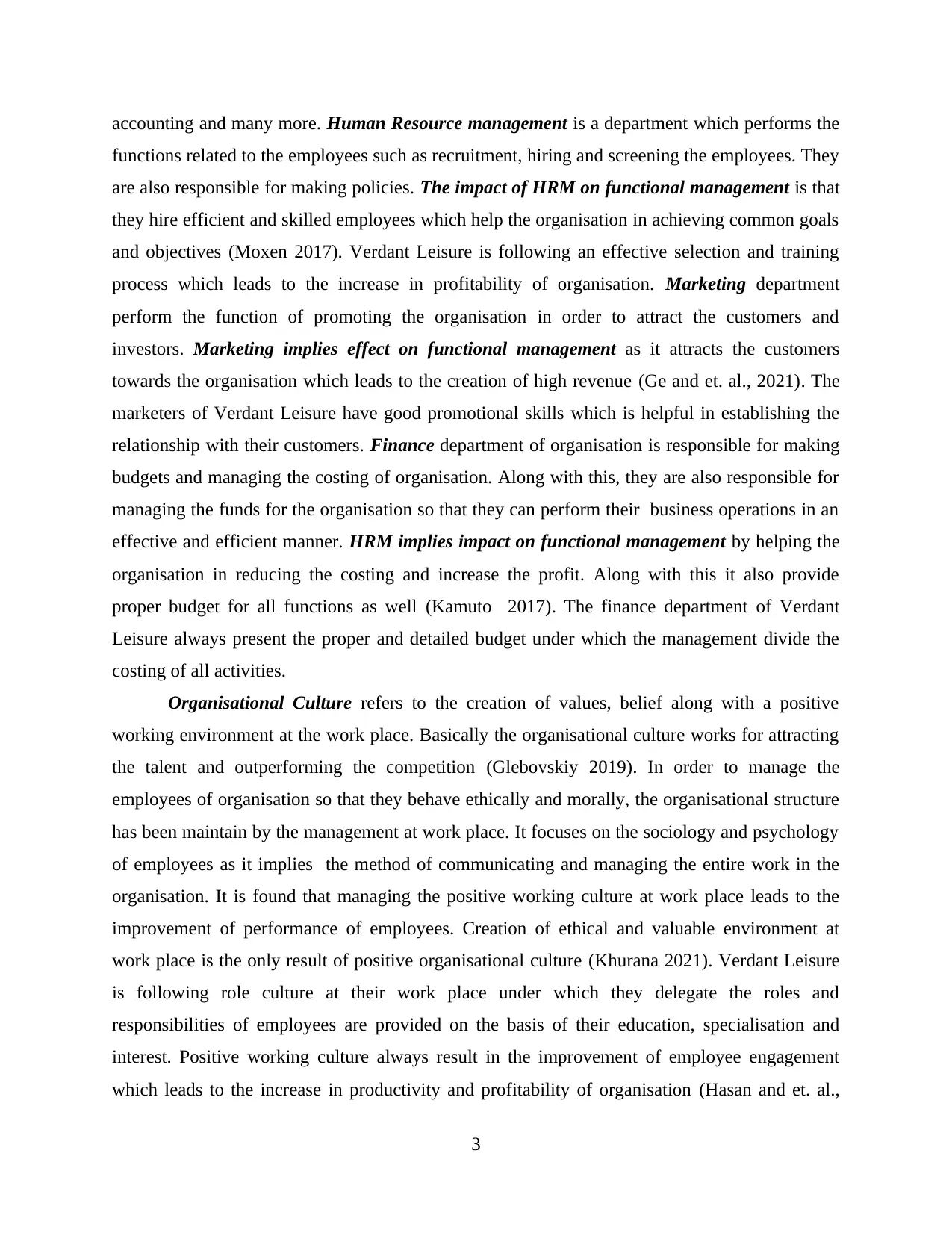
accounting and many more. Human Resource management is a department which performs the
functions related to the employees such as recruitment, hiring and screening the employees. They
are also responsible for making policies. The impact of HRM on functional management is that
they hire efficient and skilled employees which help the organisation in achieving common goals
and objectives (Moxen 2017). Verdant Leisure is following an effective selection and training
process which leads to the increase in profitability of organisation. Marketing department
perform the function of promoting the organisation in order to attract the customers and
investors. Marketing implies effect on functional management as it attracts the customers
towards the organisation which leads to the creation of high revenue (Ge and et. al., 2021). The
marketers of Verdant Leisure have good promotional skills which is helpful in establishing the
relationship with their customers. Finance department of organisation is responsible for making
budgets and managing the costing of organisation. Along with this, they are also responsible for
managing the funds for the organisation so that they can perform their business operations in an
effective and efficient manner. HRM implies impact on functional management by helping the
organisation in reducing the costing and increase the profit. Along with this it also provide
proper budget for all functions as well (Kamuto 2017). The finance department of Verdant
Leisure always present the proper and detailed budget under which the management divide the
costing of all activities.
Organisational Culture refers to the creation of values, belief along with a positive
working environment at the work place. Basically the organisational culture works for attracting
the talent and outperforming the competition (Glebovskiy 2019). In order to manage the
employees of organisation so that they behave ethically and morally, the organisational structure
has been maintain by the management at work place. It focuses on the sociology and psychology
of employees as it implies the method of communicating and managing the entire work in the
organisation. It is found that managing the positive working culture at work place leads to the
improvement of performance of employees. Creation of ethical and valuable environment at
work place is the only result of positive organisational culture (Khurana 2021). Verdant Leisure
is following role culture at their work place under which they delegate the roles and
responsibilities of employees are provided on the basis of their education, specialisation and
interest. Positive working culture always result in the improvement of employee engagement
which leads to the increase in productivity and profitability of organisation (Hasan and et. al.,
3
functions related to the employees such as recruitment, hiring and screening the employees. They
are also responsible for making policies. The impact of HRM on functional management is that
they hire efficient and skilled employees which help the organisation in achieving common goals
and objectives (Moxen 2017). Verdant Leisure is following an effective selection and training
process which leads to the increase in profitability of organisation. Marketing department
perform the function of promoting the organisation in order to attract the customers and
investors. Marketing implies effect on functional management as it attracts the customers
towards the organisation which leads to the creation of high revenue (Ge and et. al., 2021). The
marketers of Verdant Leisure have good promotional skills which is helpful in establishing the
relationship with their customers. Finance department of organisation is responsible for making
budgets and managing the costing of organisation. Along with this, they are also responsible for
managing the funds for the organisation so that they can perform their business operations in an
effective and efficient manner. HRM implies impact on functional management by helping the
organisation in reducing the costing and increase the profit. Along with this it also provide
proper budget for all functions as well (Kamuto 2017). The finance department of Verdant
Leisure always present the proper and detailed budget under which the management divide the
costing of all activities.
Organisational Culture refers to the creation of values, belief along with a positive
working environment at the work place. Basically the organisational culture works for attracting
the talent and outperforming the competition (Glebovskiy 2019). In order to manage the
employees of organisation so that they behave ethically and morally, the organisational structure
has been maintain by the management at work place. It focuses on the sociology and psychology
of employees as it implies the method of communicating and managing the entire work in the
organisation. It is found that managing the positive working culture at work place leads to the
improvement of performance of employees. Creation of ethical and valuable environment at
work place is the only result of positive organisational culture (Khurana 2021). Verdant Leisure
is following role culture at their work place under which they delegate the roles and
responsibilities of employees are provided on the basis of their education, specialisation and
interest. Positive working culture always result in the improvement of employee engagement
which leads to the increase in productivity and profitability of organisation (Hasan and et. al.,
3
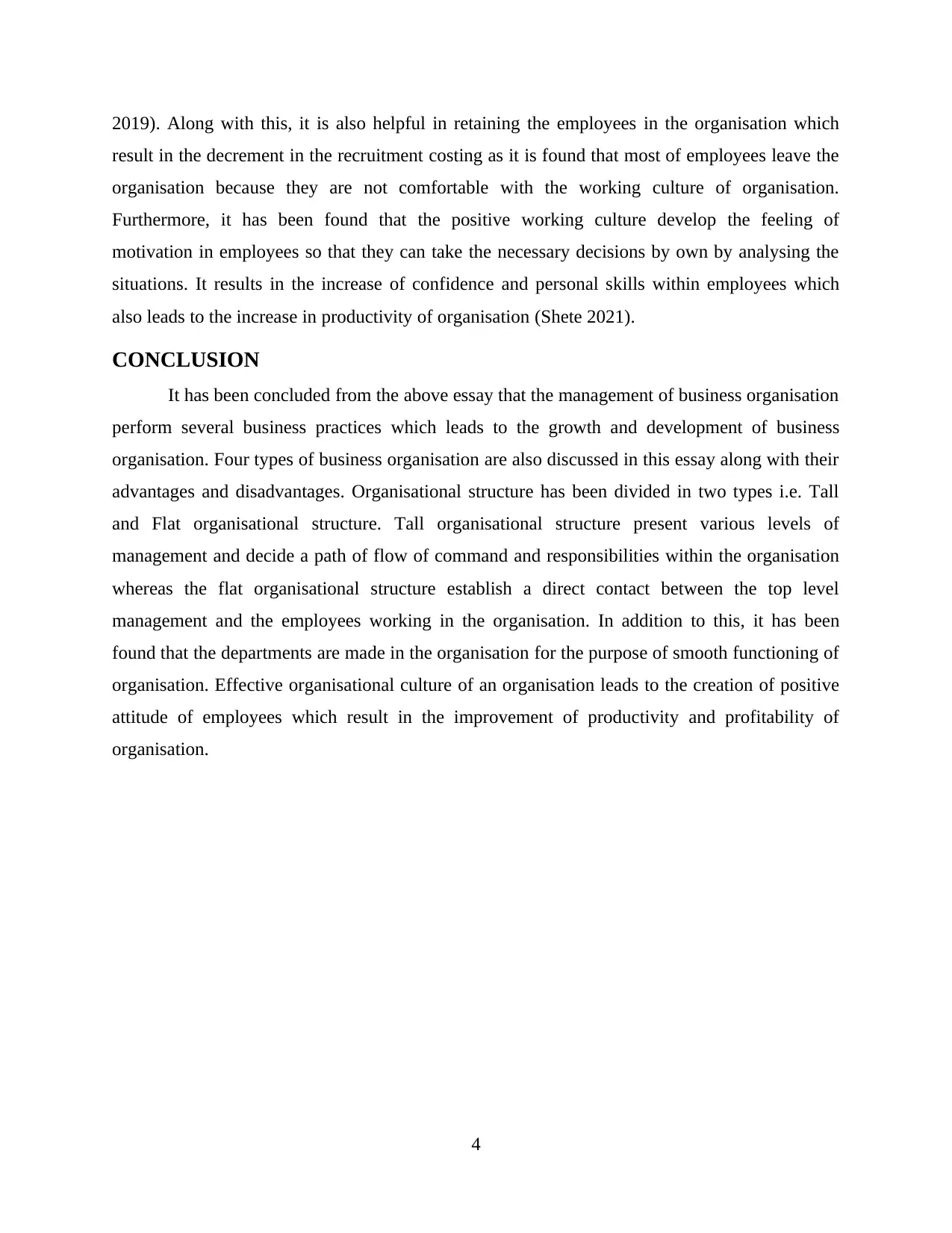
2019). Along with this, it is also helpful in retaining the employees in the organisation which
result in the decrement in the recruitment costing as it is found that most of employees leave the
organisation because they are not comfortable with the working culture of organisation.
Furthermore, it has been found that the positive working culture develop the feeling of
motivation in employees so that they can take the necessary decisions by own by analysing the
situations. It results in the increase of confidence and personal skills within employees which
also leads to the increase in productivity of organisation (Shete 2021).
CONCLUSION
It has been concluded from the above essay that the management of business organisation
perform several business practices which leads to the growth and development of business
organisation. Four types of business organisation are also discussed in this essay along with their
advantages and disadvantages. Organisational structure has been divided in two types i.e. Tall
and Flat organisational structure. Tall organisational structure present various levels of
management and decide a path of flow of command and responsibilities within the organisation
whereas the flat organisational structure establish a direct contact between the top level
management and the employees working in the organisation. In addition to this, it has been
found that the departments are made in the organisation for the purpose of smooth functioning of
organisation. Effective organisational culture of an organisation leads to the creation of positive
attitude of employees which result in the improvement of productivity and profitability of
organisation.
4
result in the decrement in the recruitment costing as it is found that most of employees leave the
organisation because they are not comfortable with the working culture of organisation.
Furthermore, it has been found that the positive working culture develop the feeling of
motivation in employees so that they can take the necessary decisions by own by analysing the
situations. It results in the increase of confidence and personal skills within employees which
also leads to the increase in productivity of organisation (Shete 2021).
CONCLUSION
It has been concluded from the above essay that the management of business organisation
perform several business practices which leads to the growth and development of business
organisation. Four types of business organisation are also discussed in this essay along with their
advantages and disadvantages. Organisational structure has been divided in two types i.e. Tall
and Flat organisational structure. Tall organisational structure present various levels of
management and decide a path of flow of command and responsibilities within the organisation
whereas the flat organisational structure establish a direct contact between the top level
management and the employees working in the organisation. In addition to this, it has been
found that the departments are made in the organisation for the purpose of smooth functioning of
organisation. Effective organisational culture of an organisation leads to the creation of positive
attitude of employees which result in the improvement of productivity and profitability of
organisation.
4
⊘ This is a preview!⊘
Do you want full access?
Subscribe today to unlock all pages.

Trusted by 1+ million students worldwide
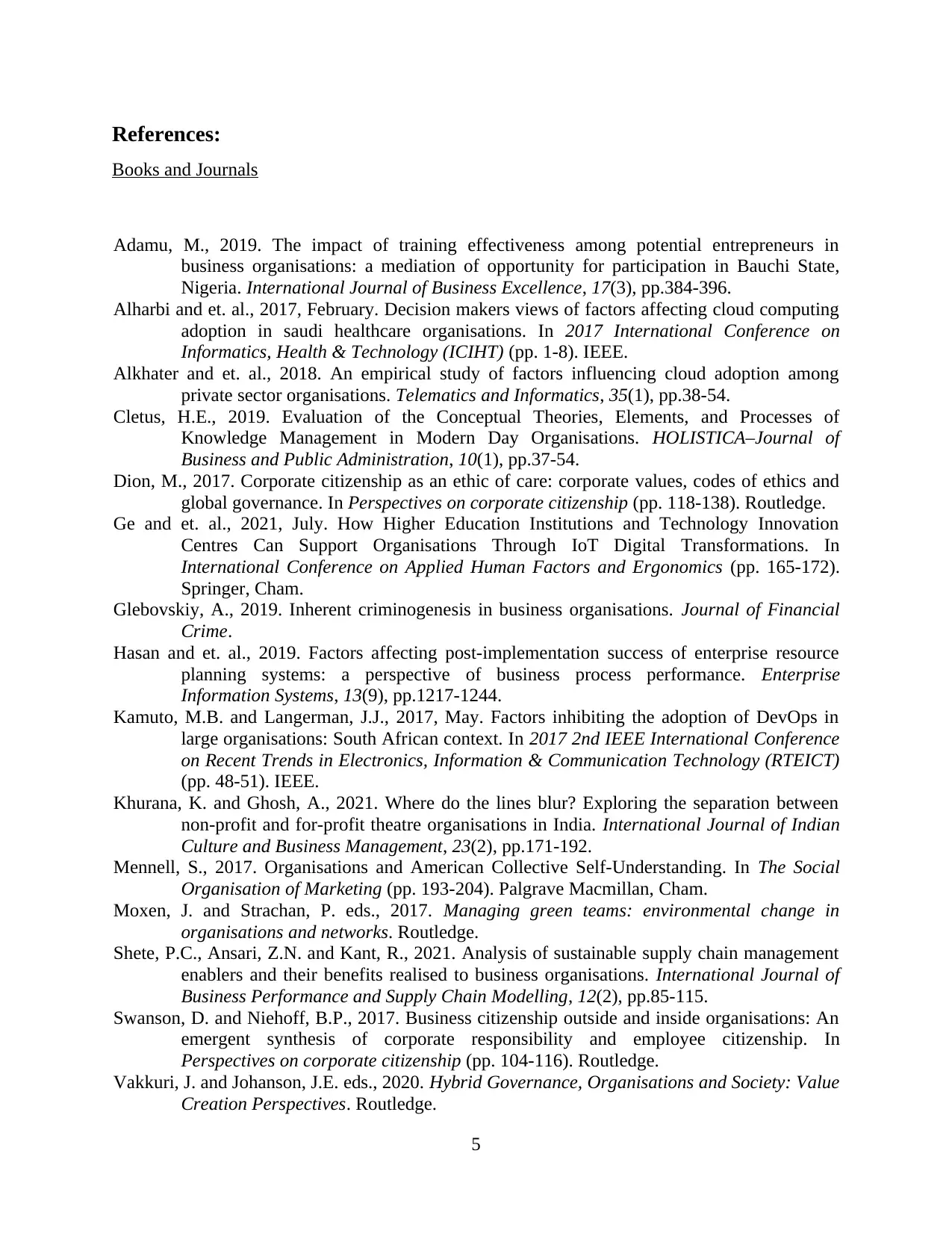
References:
Books and Journals
Adamu, M., 2019. The impact of training effectiveness among potential entrepreneurs in
business organisations: a mediation of opportunity for participation in Bauchi State,
Nigeria. International Journal of Business Excellence, 17(3), pp.384-396.
Alharbi and et. al., 2017, February. Decision makers views of factors affecting cloud computing
adoption in saudi healthcare organisations. In 2017 International Conference on
Informatics, Health & Technology (ICIHT) (pp. 1-8). IEEE.
Alkhater and et. al., 2018. An empirical study of factors influencing cloud adoption among
private sector organisations. Telematics and Informatics, 35(1), pp.38-54.
Cletus, H.E., 2019. Evaluation of the Conceptual Theories, Elements, and Processes of
Knowledge Management in Modern Day Organisations. HOLISTICA–Journal of
Business and Public Administration, 10(1), pp.37-54.
Dion, M., 2017. Corporate citizenship as an ethic of care: corporate values, codes of ethics and
global governance. In Perspectives on corporate citizenship (pp. 118-138). Routledge.
Ge and et. al., 2021, July. How Higher Education Institutions and Technology Innovation
Centres Can Support Organisations Through IoT Digital Transformations. In
International Conference on Applied Human Factors and Ergonomics (pp. 165-172).
Springer, Cham.
Glebovskiy, A., 2019. Inherent criminogenesis in business organisations. Journal of Financial
Crime.
Hasan and et. al., 2019. Factors affecting post-implementation success of enterprise resource
planning systems: a perspective of business process performance. Enterprise
Information Systems, 13(9), pp.1217-1244.
Kamuto, M.B. and Langerman, J.J., 2017, May. Factors inhibiting the adoption of DevOps in
large organisations: South African context. In 2017 2nd IEEE International Conference
on Recent Trends in Electronics, Information & Communication Technology (RTEICT)
(pp. 48-51). IEEE.
Khurana, K. and Ghosh, A., 2021. Where do the lines blur? Exploring the separation between
non-profit and for-profit theatre organisations in India. International Journal of Indian
Culture and Business Management, 23(2), pp.171-192.
Mennell, S., 2017. Organisations and American Collective Self-Understanding. In The Social
Organisation of Marketing (pp. 193-204). Palgrave Macmillan, Cham.
Moxen, J. and Strachan, P. eds., 2017. Managing green teams: environmental change in
organisations and networks. Routledge.
Shete, P.C., Ansari, Z.N. and Kant, R., 2021. Analysis of sustainable supply chain management
enablers and their benefits realised to business organisations. International Journal of
Business Performance and Supply Chain Modelling, 12(2), pp.85-115.
Swanson, D. and Niehoff, B.P., 2017. Business citizenship outside and inside organisations: An
emergent synthesis of corporate responsibility and employee citizenship. In
Perspectives on corporate citizenship (pp. 104-116). Routledge.
Vakkuri, J. and Johanson, J.E. eds., 2020. Hybrid Governance, Organisations and Society: Value
Creation Perspectives. Routledge.
5
Books and Journals
Adamu, M., 2019. The impact of training effectiveness among potential entrepreneurs in
business organisations: a mediation of opportunity for participation in Bauchi State,
Nigeria. International Journal of Business Excellence, 17(3), pp.384-396.
Alharbi and et. al., 2017, February. Decision makers views of factors affecting cloud computing
adoption in saudi healthcare organisations. In 2017 International Conference on
Informatics, Health & Technology (ICIHT) (pp. 1-8). IEEE.
Alkhater and et. al., 2018. An empirical study of factors influencing cloud adoption among
private sector organisations. Telematics and Informatics, 35(1), pp.38-54.
Cletus, H.E., 2019. Evaluation of the Conceptual Theories, Elements, and Processes of
Knowledge Management in Modern Day Organisations. HOLISTICA–Journal of
Business and Public Administration, 10(1), pp.37-54.
Dion, M., 2017. Corporate citizenship as an ethic of care: corporate values, codes of ethics and
global governance. In Perspectives on corporate citizenship (pp. 118-138). Routledge.
Ge and et. al., 2021, July. How Higher Education Institutions and Technology Innovation
Centres Can Support Organisations Through IoT Digital Transformations. In
International Conference on Applied Human Factors and Ergonomics (pp. 165-172).
Springer, Cham.
Glebovskiy, A., 2019. Inherent criminogenesis in business organisations. Journal of Financial
Crime.
Hasan and et. al., 2019. Factors affecting post-implementation success of enterprise resource
planning systems: a perspective of business process performance. Enterprise
Information Systems, 13(9), pp.1217-1244.
Kamuto, M.B. and Langerman, J.J., 2017, May. Factors inhibiting the adoption of DevOps in
large organisations: South African context. In 2017 2nd IEEE International Conference
on Recent Trends in Electronics, Information & Communication Technology (RTEICT)
(pp. 48-51). IEEE.
Khurana, K. and Ghosh, A., 2021. Where do the lines blur? Exploring the separation between
non-profit and for-profit theatre organisations in India. International Journal of Indian
Culture and Business Management, 23(2), pp.171-192.
Mennell, S., 2017. Organisations and American Collective Self-Understanding. In The Social
Organisation of Marketing (pp. 193-204). Palgrave Macmillan, Cham.
Moxen, J. and Strachan, P. eds., 2017. Managing green teams: environmental change in
organisations and networks. Routledge.
Shete, P.C., Ansari, Z.N. and Kant, R., 2021. Analysis of sustainable supply chain management
enablers and their benefits realised to business organisations. International Journal of
Business Performance and Supply Chain Modelling, 12(2), pp.85-115.
Swanson, D. and Niehoff, B.P., 2017. Business citizenship outside and inside organisations: An
emergent synthesis of corporate responsibility and employee citizenship. In
Perspectives on corporate citizenship (pp. 104-116). Routledge.
Vakkuri, J. and Johanson, J.E. eds., 2020. Hybrid Governance, Organisations and Society: Value
Creation Perspectives. Routledge.
5
Paraphrase This Document
Need a fresh take? Get an instant paraphrase of this document with our AI Paraphraser
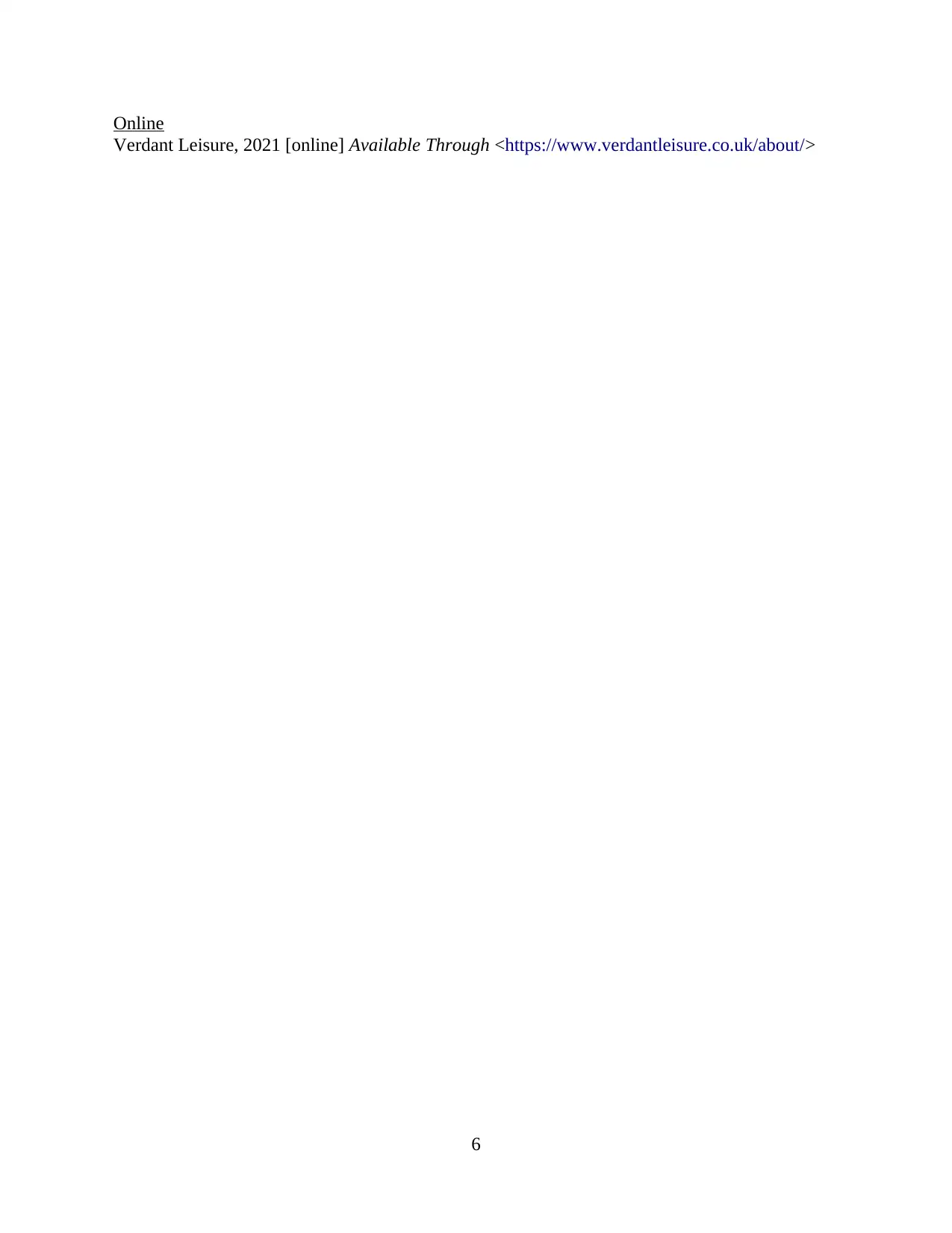
Online
Verdant Leisure, 2021 [online] Available Through <https://www.verdantleisure.co.uk/about/>
6
Verdant Leisure, 2021 [online] Available Through <https://www.verdantleisure.co.uk/about/>
6
1 out of 8
Related Documents
Your All-in-One AI-Powered Toolkit for Academic Success.
+13062052269
info@desklib.com
Available 24*7 on WhatsApp / Email
![[object Object]](/_next/static/media/star-bottom.7253800d.svg)
Unlock your academic potential
Copyright © 2020–2025 A2Z Services. All Rights Reserved. Developed and managed by ZUCOL.



